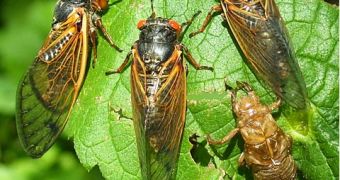Entomologists and ordinary folks in the United States are now readying themselves to come face to face with billions of cicadas. The insects are expected to show up on the country's East Coast between mid-April and late May.
Specialists explain that the cicadas set to soon swarm the US East Coast are known to the scientific community as Brood II cicadas. These insects live for nearly twenty years, yet spend most of their time hiding in the underground and feeding on the roots of trees.
Thus, it is believed that the billions of cicadas that will show up in American states spreading from New England to North Carolina have been hiding in the underground for nearly 17 years.
Their leaving the underground and swarming above the ground has to do with their entering the mating season. Opposing Views informs us that, noise aside, these insects do not constitute a threat to either vegetation or local wildlife.
Furthermore, entomologists wish to reassure that human communities run absolutely no risks of being negatively impacted by their coming face to face with these insects.
“The specific thing about these 17-year cicadas is they are going to be a very dark colored body. They have really bright red eyes, and they also have bright red wing veins,” explains Craig Gibbs, currently working with the Wildlife Conservation Society's Queens Zoo.
“What will happen is the nymphs will come up and they will shed their nymphal skin and they'll crawl up into the trees and they'll take about five days to harden and then they'll start for next four to six weeks calling and looking for mates,” said entomologist went on to argue.
The cicadas are expected to make their appearance once the local ground temperature hits 64 degrees Fahrenheit (about 17.8 degrees Celsius). Once their mating season comes to an end, these adult cicadas will die.
A new generation will once again swarm these regions in the year 2030, entomologists say.

 14 DAY TRIAL //
14 DAY TRIAL //